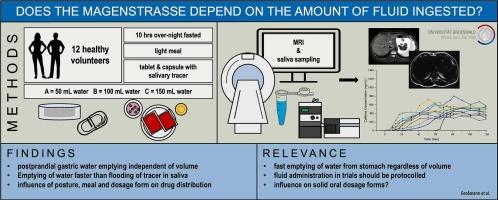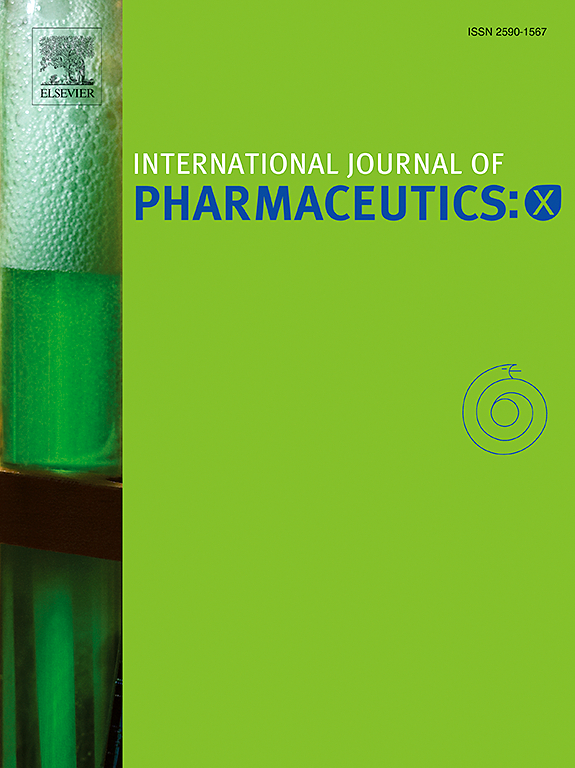Magenstrasse的外观是否取决于消耗的水量?
IF 6.4
2区 医学
Q1 PHARMACOLOGY & PHARMACY
引用次数: 0
摘要
胃路(Magenstrasse)是一种现象,描述了在吃完固体食物后,胃里的水会迅速排出。到目前为止,它的存在已经证明水量为150毫升或更多。这项三臂、随机、交叉、12个受试者的研究的目的是调查Magenstrasse是否也存在于较小的水量中。为此目的,使用磁共振成像确定在清淡餐后给予50,100或150ml水的胃排空。在每一剂水的同时,服用含有咖啡因和氧化铁的速溶压缩包衣片剂,以及含有稳定同位素标记的咖啡因和中链甘油三酯的硬胶囊。这使得在MR图像上确定各自形式在胃中的初始定位成为可能,作为饮水量的函数,并且还可以使用研究中获得的唾液样本确定两种咖啡因变体的排空率,并使用LC-MS/MS进行量化。胃排空摄入的水是迅速的,通常在大约20分钟后完成,无论应用的体积。与消耗的水相比,天然咖啡因和稳定同位素标记的咖啡因的胃排空被延迟。胶囊通常漂浮在液体和食糜上,而压缩包衣片通常嵌入食糜中。本文章由计算机程序翻译,如有差异,请以英文原文为准。

Does the appearance of the Magenstrasse depend on the amount of water consumed?
The Magenstrasse (stomach road) is a phenomenon describing the rapid evacuation of water drunken after a solid meal from the stomach. So far, its existence has been demonstrated for water volumes of 150 mL or more. The aim of this three-arm, randomised, cross-over, 12-subject study was to investigate whether the Magenstrasse is also present for smaller water volumes. For this purpose, gastric emptying of 50, 100 or 150 mL of water that was administered after a light meal was determined using MR imaging. With each dose of water, a fast-dissolving compression coated tablet containing caffeine and iron oxide as well as a hard capsule containing stable isotope labelled caffeine and medium-chain triglycerides were administered. This made it possible to determine the initial localization of the respective forms in the stomach on MR images as a function of the amount of water drunk, and also to determine the emptying rates of the two caffeine variants using saliva samples that were obtained in the study and quantified using LC-MS/MS. Gastric emptying of the ingested water was rapid and usually completed after approximately 20 min, regardless of the applied volume. In contrast to the consumed water, gastric emptying of natural caffeine and stable isotope labelled caffeine was delayed. The capsule usually floated on liquid and chyme, whereas the compression coated tablet was often embedded in chyme.
求助全文
通过发布文献求助,成功后即可免费获取论文全文。
去求助
来源期刊

International Journal of Pharmaceutics: X
Pharmacology, Toxicology and Pharmaceutics-Pharmaceutical Science
CiteScore
6.60
自引率
0.00%
发文量
32
审稿时长
24 days
期刊介绍:
International Journal of Pharmaceutics: X offers authors with high-quality research who want to publish in a gold open access journal the opportunity to make their work immediately, permanently, and freely accessible.
International Journal of Pharmaceutics: X authors will pay an article publishing charge (APC), have a choice of license options, and retain copyright. Please check the APC here. The journal is indexed in SCOPUS, PUBMED, PMC and DOAJ.
The International Journal of Pharmaceutics is the second most cited journal in the "Pharmacy & Pharmacology" category out of 358 journals, being the true home for pharmaceutical scientists concerned with the physical, chemical and biological properties of devices and delivery systems for drugs, vaccines and biologicals, including their design, manufacture and evaluation. This includes evaluation of the properties of drugs, excipients such as surfactants and polymers and novel materials. The journal has special sections on pharmaceutical nanotechnology and personalized medicines, and publishes research papers, reviews, commentaries and letters to the editor as well as special issues.
 求助内容:
求助内容: 应助结果提醒方式:
应助结果提醒方式:


